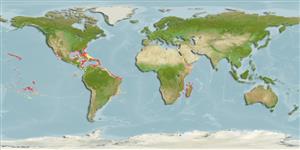Elasmobranchii (sharks and rays) >
Squaliformes (Sleeper and dogfish sharks) >
Squalidae (Dogfish sharks)
Etymology: Cirrhigaleus: Latin, cirrus = curl fringe + Greek, galeos = a shark (Ref. 45335).
Issue
Genus B. Mundy, pers. comm.
Environment: milieu / climate zone / depth range / distribution range
Ecology
Marine; bathydemersal; depth range 200 - 650 m (Ref. 55584). Deep-water; 35°N - 35°S, 171°W - 51°E (Ref. 55304)
Western Atlantic: North Carolina to the Florida Keys (Ref. 3814) and the northern Gulf of Mexico. Western Indian Ocean: southern Mozambique to South Africa; also Reunion, Comoros, and the Aldabra islands (Ref. 33390). Eastern Central Pacific: Hawaiian Islands.
Length at first maturity / Size / Weight / Age
Maturity: Lm 110.0 range ? - ? cm
Max length : 120 cm TL male/unsexed; (Ref. 247); 115.0 cm TL (female)
Dorsal spines (total): 2; Anal spines: 0. A heavy-bodied dogfish with a blunt, rounded snout, large denticles and noticeably rough skin; body without spots; 1st dorsal fin spine behind pectoral fins (Ref. 5578). Dark grey or brown above, lighter below; white edges on fins (Ref. 5578); juveniles brown (Ref. 6577).
Found on the upper continental and insular slopes (Ref. 247). Adults feed on bony fishes and squids (Ref. 5213). Ovoviviparous (Ref. 205), with 21 to 22 young in a litter (Ref. 247).
Ovoviviparous, with 21 to 22 young in a litter.
Compagno, L.J.V., 1984. FAO Species Catalogue. Vol. 4. Sharks of the world. An annotated and illustrated catalogue of shark species known to date. Part 1 - Hexanchiformes to Lamniformes. FAO Fish. Synop. 125(4/1):1-249. Rome, FAO. (Ref. 247)
IUCN Red List Status (Ref. 130435: Version 2024-1)
Threat to humans
Harmless
Human uses
Fisheries: of no interest
Tools
Special reports
Download XML
Internet sources
Estimates based on models
Preferred temperature (Ref.
123201): 9.7 - 18.4, mean 13.4 °C (based on 113 cells).
Phylogenetic diversity index (Ref.
82804): PD
50 = 0.6250 [Uniqueness, from 0.5 = low to 2.0 = high].
Bayesian length-weight: a=0.00355 (0.00168 - 0.00747), b=3.09 (2.91 - 3.27), in cm total length, based on LWR estimates for this (Sub)family-body shape (Ref.
93245).
Trophic level (Ref.
69278): 4.5 ±0.62 se; based on food items.
Resilience (Ref.
120179): Low, minimum population doubling time 4.5 - 14 years (Fec=21-22).
Fishing Vulnerability (Ref.
59153): High to very high vulnerability (72 of 100).
